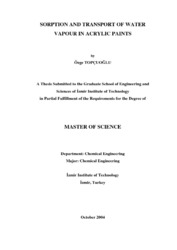Please use this identifier to cite or link to this item:
https://hdl.handle.net/11147/3693Full metadata record
| DC Field | Value | Language |
|---|---|---|
| dc.contributor.advisor | Alsoy Altınkaya, Sacide | en |
| dc.contributor.author | Topçuoğlu, Özge | - |
| dc.date.accessioned | 2014-07-22T13:52:10Z | - |
| dc.date.available | 2014-07-22T13:52:10Z | - |
| dc.date.issued | 2004 | en |
| dc.identifier.uri | http://hdl.handle.net/11147/3693 | - |
| dc.description | Thesis (Master)--Izmir Institute of Technology, Chemical Engineering, Izmir, 2004 | en |
| dc.description | Includes bibliographical references (leaves: 70-73) | en |
| dc.description | Text in English; Abstract: Turkish and English | en |
| dc.description | xii, 79 leaves | en |
| dc.description.abstract | Sorption, diffusion and permeation data were obtained for water vapour in water borne acrylic paint films and in the pure binder of the paints which is methylmethacrylate-co-butylacrylate copolymer. Paint films which have the same formulation but contain different amount of binder were characterized to determine elements and their form, distribution of the ingredients, structure, functional groups, degradation temperature, glass transition temperature and roughness of the surfaces using energy dispersive X-ray (EDX), X-ray diffraction, map diagrams, scanning electron microscope, fourier transform infrared spectroscopy, thermal gravimetry, differential scanning calorimetry (DSC) and atomic force microscope, respectively. Diffusivity and solubility of water in the paint films were measured at T. 30 oC while for the pure copolymer film similar data were collected at T. 30 oC and T. 40 oC, using a new type of gravimetric sorption apparatus called magnetic suspension balance. Fickian sorption is observed for both the paint films and the pure copolymer. Diffusivity and permeability of water increases while the maximum water sorption capacity decreases with decreasing binder fraction in the paint films. Scanning electron microscope pictures and map diagrams show a nonhomogeneous distribution and flocculation of the pigments in the paint films with low binder content. Transport properties (diffusivity, permeability, water sorption capacity) of the pure copolymer are similar to those determined for the paint film containing 40% binder. The sorption data for the paint films and the pure copolymer were interpreted using Flory-Huggins theory and ENSIC model, respectively. The Zimm and Lundberg cluster integral was used to determine the extend of clustering of water molecules. According to the predictions, water form clusters both in the paint films and in the pure copolymer. Degree of clustering and the change of mean cluster size with sorption appears to be larger for the pure copolymer. | en |
| dc.language.iso | en | en_US |
| dc.publisher | Izmir Institute of Technology | en |
| dc.rights | info:eu-repo/semantics/openAccess | en_US |
| dc.subject.lcc | QD382.W3 .T67 2004 | en |
| dc.subject.lcsh | Water-soluble oil paint | en |
| dc.subject.lcsh | Water-soluble polymers | en |
| dc.title | Sorption and transport of water vapour in acrylic paints | en_US |
| dc.type | Master Thesis | en_US |
| dc.institutionauthor | Topçuoğlu, Özge | - |
| dc.department | Thesis (Master)--İzmir Institute of Technology, Chemical Engineering | en_US |
| dc.relation.publicationcategory | Tez | en_US |
| item.openairecristype | http://purl.org/coar/resource_type/c_18cf | - |
| item.grantfulltext | open | - |
| item.cerifentitytype | Publications | - |
| item.fulltext | With Fulltext | - |
| item.openairetype | Master Thesis | - |
| item.languageiso639-1 | en | - |
| Appears in Collections: | Master Degree / Yüksek Lisans Tezleri | |
Files in This Item:
| File | Description | Size | Format | |
|---|---|---|---|---|
| T000498.pdf | MasterThesis | 7.84 MB | Adobe PDF |  View/Open |
CORE Recommender
Page view(s)
110
checked on Nov 18, 2024
Download(s)
50
checked on Nov 18, 2024
Google ScholarTM
Check
Items in GCRIS Repository are protected by copyright, with all rights reserved, unless otherwise indicated.